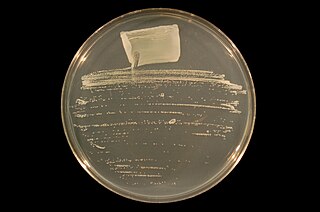
Ensifer is a genus of nitrogen-fixing bacteria (rhizobia), three of which have been sequenced.
Algoriphagus is a genus in the phylum Bacteroidota (Bacteria).
Marinobacter algicola is a Gram-negative, aerobic and moderately halophilic bactebacterium from the genus of Marinobacter which has been isolated from the dinoflagellate Gymnodinium catenatum in Scotland.
Marinobacter antarcticus is a Gram-negative, aerobic, halotolerant, rod-shaped and motile bacterium from the genus of Marinobacter which has been isolated from Antarctic sediments.
Marinobacter daepoensis is a Gram-negative, non-spore-forming, slightly halophilic and motile bacterium from the genus of Marinobacter which has been isolated from sea water from the Yellow Sea in Korea.
Marinobacter daqiaonensis is a Gram-negative and moderately halophilic bacterium from the genus of Marinobacter which has been isolated from sediments of the Daqiao saltern in Qingdao.
Marinobacter flavimaris is a Gram-negative, non-spore-forming, slightly halophilic and motile bacterium from the genus of Marinobacter which has been isolated from sea water from the Yellow Sea in Korea.
Marinobacter gudaonensis is a Gram-negative and rod-shaped bacterium from the genus of Marinobacter which has been isolated from saline soil which was contaminated with oil from the Shengli Oil Field in China.
Marinobacter guineae is a Gram-negative, aerobic and moderately halophilic bacterium from the genus of Marinobacter which has been isolated from the South Shetland Islands from the Antarctica.
Marinobacter koreensis is a Gram-negative, straight-rod-shaped, aerobic and moderately halophilic bacterium from the genus of Marinobacter which has been isolated from sea sand from Pohang in Korea.
Marinobacter lacisalsi is a Gram-negative, non-spore-forming, aerobic and moderately halophilic bacterium from the genus of Marinobacter which has been isolated from the lake from Fuente de Piedra in Spain.
Marinobacter maritimus is a Gram-negative, psychrotolerant and motile bacterium from the genus of Marinobacter which has been isolated from sea water near the Kerguelen islands.
Marinobacter psychrophilus is a Gram-negative, rod-shaped, psychrophilic and motile bacterium from the genus of Marinobacter which has been isolated from sea-ice of the Canadian Basin.
Marinobacter salicampi is a Gram-negative, rod-shaped and motile bacterium from the genus of Marinobacter which has been isolated from the Yellow Sea in Korea.
Marinobacter salsuginis is a Gram-negative and moderately halophilic bacterium from the genus of Marinobacter which has been isolated from seawater from the Shaban Deep from the Red Sea. The strain BS2 of Marinobacter salsuginis can reduce the mortality of the shrimps Penaeus monodon and Litopenaeus vannamei by killing the dinoflagellate Noctiluca scintillans. The strain 5N-3 can degrade 1,2-Dichloroethene (cis-DCE) in the absence of inducing substrates like phenol.[6]
Marinobacter santoriniensis is a Gram-negative, facultatively anaerobic, non-spore-forming and motile bacterium from the genus of Marinobacter which has been isolated from hydrothermal sediments in Santorini in Greece. Marinobacter santoriniensis can metabolize arsenate and arsenite.
Marinobacter segnicrescens is a Gram-negative, non-spore-forming, ellipsoid-shaped, moderately halophilic and motile bacterium from the genus of Marinobacter which has been isolated from sediments from the South China Sea.
Marinobacter xestospongiae is a Gram-negative, slightly halophilic and non-spore-forming bacterium from the genus of Marinobacter which has been isolated from the sponge Xestospongia testudinaria from the sea coast of Saudi Arabia.
Marinobacter zhejiangensis is a Gram-negative, aerobic, halophilic and rod-shaped bacterium from the genus of Marinobacter which has been isolated from sediments from the East China Sea.
Cyclobacterium is a mesophilic, neutrophilic, chemoorganotrophic and aerobic bacterial genus from the family of Cyclobacteriaceae. Cyclobacterium bacteria occur in marine habitats
